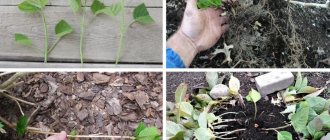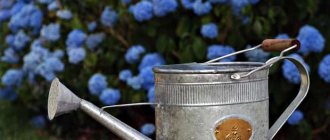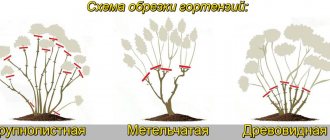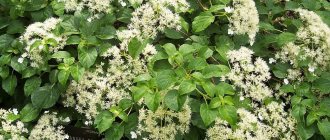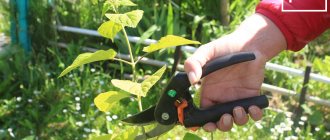Hydrangea is a flowering shrub that often decorates gardens and summer cottages with its lush inflorescences. In order for the perennial to please the eyes of the owner and passers-by every year, timely fertilizing is indispensable and you need to know how to fertilize hydrangea in August and September. This way the plant will have time to prepare for the upcoming winter, will not be afraid of severe frosts and is guaranteed to wake up in the spring.
Timing of autumn feeding
They begin to prepare hydrangea for wintering in late August or early September. By this time, the bush had already faded and stopped growing new shoots. The main task of the gardener is to replenish the balance of nutrients in the soil, depleted during the active growing season and flowering. Before the onset of frost, the hydrangea stems should be covered with a dense layer of bark. The root system must accumulate a supply of water and necessary elements.
The first autumn feeding is carried out in September, when the roots of the plant actively absorb nutrients from the soil. The next time you should feed the shrub is after formative and sanitary pruning of the shoots. The duration depends on climatic conditions. As a rule, it coincides with the beginning of leaf fall. The last time the hydrangea is fertilized with organic matter is at the same time as covering it for the winter.
Important! The timing of fertilizing depends on the variety. The earlier the bush blooms, the earlier it is fertilized.
Treatment against pests and diseases
Insect pest larvae and adults can hide in plant debris, stems, and soil. Here they successfully winter, awaken in the spring and begin activity, causing serious damage to the hydrangea. Pathogens and pathogenic fungi will also overwinter in the soil, so preventive autumn treatment is important.
Spraying is carried out after harvesting a flower bed or tree trunk. Fallen leaves, dry branches, weeds, and garbage must be carefully collected and burned outside the flower garden. If this is not done, the processing efficiency will be reduced by 2 times.
It is best to use 3% Bordeaux mixture for spraying. This drug is used to treat the bush itself and the ground around it at a distance of at least 1 m or according to the projection of the crown.
How to feed hydrangea in the fall
The main elements that a perennial plant needs in the fall are phosphorus and potassium. They help the roots survive frosts and accumulate strength for the next season. Fertilizers containing nitrogen provoke unwanted growth of young shoots. New growth is not able to survive low temperatures, thus weakening the hydrangea.
How to feed hydrangea in September
At the beginning of autumn, the main care for hydrangea consists of fertilizing the depleted soil. During this period, vegetative buds are formed. If there is a lack of nutrients, the number of flowers for the next season will be significantly reduced. For fertilizer, solutions of superphosphate and potassium sulfate are chosen. The application rate is 2 tbsp. fertilizing for 10 liters of water. Liquid fertilizing is applied to the soil moistened the day before at the rate of 5 liters per bush.
When choosing a ready-made fertilizer for a flowering perennial, you should pay attention to the following preparations:
- Potassium sulfate. Helps reduce the temperature at which water inside the root system begins to freeze;
- Superphosphate. Phosphorus increases the defenses of hydrangea against various diseases. Helps form a large number of vegetative buds;
- Complex mineral preparations for hydrangeas, such as Fertika, GreenWorld, Bona Forte.
The following can be used as organic fertilizers:
- vermicompost;
- humus;
- green fertilizer from weeds;
- infusion of mullein or bird droppings.
Such fertilizers will not only replenish nutrient deficiencies, but also improve the structure of the soil. Rotted manure or droppings are dissolved in warm water in a ratio of 1 part of the substance to 10 parts of liquid. They spill the soil around the bush, retreating 15-20 cm from the center. Using humus, mulch the beds in the tree trunk circle. You can feed hydrangea with manure, but not fresh manure, as it will burn the plant’s root system.
How to feed hydrangea in the fall after pruning
When the plant begins to lose leaves, gardeners carry out formative and sanitary pruning of the bushes. At this moment, the hydrangea is under stress, and fertilizing is not carried out. Fallen leaves are collected and burned to prevent the spread of diseases and harmful insects. After 2 weeks, you can feed the bush with preparations based on potassium and phosphorus. In dry weather, it is recommended to use liquid solutions, in the rainy season - dry substances in the form of granules or powder.
How to feed hydrangea in the fall before sheltering
The last fertilization of the perennial should be carried out no later than 3-4 weeks before the onset of frost. Before providing the plant with shelter for the winter, the hydrangea can be fed with organic matter. It is recommended to mulch the tree trunk circle with humus or peat. This measure will protect the crop during the cold period. As organic compounds gradually decompose, they will release heat and nutrients.
Good to know! Mulch made from acidic peat and pine needles will further increase the acidity of the soil and loosen its structure.
Mineral fertilizers
An overview of the main traditional fertilizers that have proven themselves to be used in agriculture for many years is presented in the table.
| Fertilizer group | Element value | Fertilizer name | Application period |
| Nitrogen | Nitrogen ensures the growth of green mass: stems, leaves. Promotes root system development | Urea (urea); nitrate: sodium, calcium, ammonium; ammonium sulfate | Spring – early summer |
| Potash | Potassium is involved in cell division and growth, water metabolism, sugar transport, and improves immunity. Important during budding, as it promotes the formation of new flower buds | Potassium sulfate (potassium sulfate), potassium magnesium, potassium monophosphate | First half of summer |
| Phosphorus | Phosphorus is needed for flowering. Accelerates development, increases frost resistance and drought resistance | Single superphosphate, double superphosphate, potassium monophosphate | Second half of summer - during flowering |
| Complexes | Include microelements: sulfur – required for the synthesis of protein molecules, chlorophyll, redox reactions; calcium - takes part in metabolism, is found in cell membranes, holds them together; magnesium – part of chlorophyll, necessary for metabolism and respiration | Ammophoska: nitrogen, phosphorus, potassium, sulfur, calcium, magnesium. Azofoska (nitroammofoska): nitrogen, phosphorus, potassium, sulfur, magnesium | Mostly in early spring |
It is not recommended to apply wood ash as a mineral fertilizer for most types of hydrangea. It alkalizes the soil, which has a bad effect on the decorative appearance of the bushes: it leads to chlorosis (yellowing, discoloration of foliage), and an undesirable change in the color of the petals.
Ready-made drugs
Now buying the right fertilizer is not a problem. Among the mineral compositions for hydrangeas presented by Russian and foreign manufacturers, Fertika, Pokon, GreenWorld, Agricola Aqua, Buyskie have proven themselves well.
Recommended dosages, timing and methods of application are usually indicated in the instructions on the package
Thus, Pokon complex fertilizer (produced in the Netherlands) for hydrangeas and rhododendrons, due to its long-term action, provides the plant with proper nutrition for 6 months. The composition is applied once during planting or in the spring. The granules are scattered over the surface of the soil, covered, and watered well. According to reviews, with this fertilizer, hydrangea will not only bloom profusely, but also have healthy green foliage, thanks to magnesium.
Is it necessary to feed hydrangea with potassium magnesia in the fall?
Kalimag (trade name kalimagnesia) is a universal three-component drug that contains magnesium, potassium and sulfur. It is used to increase the immunity of flowering perennial plants before wintering and to improve the decorative appearance of inflorescences.
Calimagnesia is often used to fertilize roses. Some gardeners also use the drug for autumn feeding of hydrangeas. Water-soluble components are quickly absorbed by the root system. The plant receives the necessary elements to survive the cold and quickly restore vegetation in the spring.
In the fall, fertilize each perennial bush in dry or liquid form. To prepare a liquid solution, use 20 g of the drug per 10 liters of water. This amount is enough to fertilize 1 adult bush. In dry form, 20 g of powder is embedded in the soil around the trunk, then watered.
Differences in feeding different species
In order for hydrangea to annually delight with beautiful caps of lush inflorescences, it is necessary to take into account the needs for fertilizers of different types and varieties. There are some nuances of flower feeding that gardeners note.
How to feed tree hydrangea in the fall
Tree hydrangea is one of the most frost-resistant varieties. Some varieties are able to tolerate temperatures down to -20-30°C. In addition to the basic elements, it needs magnesium and iron. In the autumn, it responds well to mulching the soil with humus and peat. To make the shoots denser, it is recommended to water the soil with a weak solution of potassium permanganate.
How to feed large-leaved hydrangea in the fall
There are many varieties with a variety of colors of large-leaved species. The color of the petals directly depends on the composition of the soil.
When choosing fertilizer for autumn feeding of hydrangea, you should take into account the influence of elements on this parameter.
- Blue and blue varieties need acidic soil and moderate amounts of phosphorus. In autumn they are fed with a liquid solution based on potassium sulfate and ammonium sulfate. It is recommended to use pine needles and acidic peat as mulch.
- Pink inflorescences require a high phosphorus content. From ready-made preparations, you can use Agricola 2. Wood ash or dolomite flour is chosen for organic feeding.
- Red and white varieties can be fertilized in the autumn with superphosphate or complex mineral mixtures.
To maintain the required level of acidity, gardeners sometimes resort to folk remedies. Rich blue shades of inflorescences are obtained by watering hydrangeas with acidified water. Dilute 60 g of lemon juice or 100 ml of table vinegar per 10 liters of water. The resulting solution is poured onto the soil around the bushes.
Good to know! In flower shops you can purchase ready-made preparations developed specifically for blue hydrangea varieties.
Pruning and feeding paniculate hydrangea
In autumn, the bushes are subjected to sanitary and formative pruning. The main task is to remove old, damaged branches and shoots growing inside the crown. In addition, all leaves are trimmed. After the procedure, mineral and organic fertilizers cannot be applied for 2 weeks.
Before sheltering for the winter, be sure to mulch the soil around the trunk with humus, sawdust or spruce branches. The root system of the variety is located close to the surface of the earth. For successful wintering she needs additional protection. The rules for feeding paniculate hydrangea for color are the same as for large-leaved varieties.
Advice from experienced gardeners
In the fall, after harvesting vegetables, the gardener has the opportunity to devote time to caring for other crops, including hydrangea. Having information about the characteristics of a plant, you can use it for your benefit. What other work needs to be done in the autumn for good growth and flowering of your favorite hydrangea? Experienced gardeners give the following recommendations:
- In the fall, you can replant and replant paniculate and tree hydrangeas, if necessary. With the large-leaved variety, such manipulations are carried out only in spring due to its low frost resistance. Hydrangea is planted in fertile and loose soil that is highly acidic. To make the transplant less traumatic, the lump of earth near the roots is not destroyed. This event is carried out in early autumn so that the plant can take root properly before frost.
- Young hydrangea specimens that were planted in the fall are fertilized only in the second spring. For the first year and a half of their life, they will have enough nutrients that were placed in the hole during planting.
- Not only large-leaved, but also prickly, serrate, petiolate, oak-leaved, and liana-shaped hydrangeas are pruned minimally in the fall due to the fact that flowering in these species occurs on two-year-old shoots, which means they must be preserved. These plants are trimmed for sanitary purposes. Only old, twisted, weak and diseased shoots are removed. Do not touch strong young branches.
- With the arrival of frost, the tree trunk circle is mulched with peat, coniferous wood shavings, and crushed pine bark. The layer thickness should be 20 cm. In cold regions, the bushes are additionally covered with spruce branches, straw, and non-woven material. After snow falls, it is thrown onto the bush. The shoots of tall tree-like hydrangea are laid on the ground, having previously laid out boards or pieces of slate. Some build a vertical shelter for such bushes by installing a net around it, the internal space of which is filled with dry insulation - leaves, chopped straw. In spring, it is important to remove the cover in a timely manner, preventing the bushes from dampening off.
- The gardener can influence the color of large leaf hydrangea flowers. To do this, in early spring, before the buds set, a solution of ammonium chloride is added or the tree trunk is sprinkled with ammonium sulfate and watered abundantly to obtain blue inflorescences. You can achieve pink coloring of flowers by watering the bush with a solution of potassium permanganate or embedding chalk in the tree trunk. In other species, the color scheme of the buds depends on the varietal characteristics.
In no case should you skip autumn feeding of hydrangea, otherwise the plant will be deprived of the opportunity to recover after flowering and will enter the winter weakened. In addition, follow other recommendations for caring for shrubs at this time of year. If you take proper care, hydrangea will become a real decoration of the site and a source of your pride.
Features of autumn feeding of hydrangea and preparation for winter
Autumn accounts for a significant part of the work required to care for hydrangeas. During this period, it is important to replenish the moisture level, saturate the soil with nutrients and properly prepare the plant for winter. The secret of lush and long-lasting flowering depends on the efforts expended by the gardener and compliance with basic rules:
- During autumn feeding, nitrogen-containing preparations should not be used;
- It is not recommended to introduce a large amount of organic matter; its excess inhibits the culture;
- it is advisable to give preference to liquid fertilizers, which are more easily absorbed by the root system;
- creating a mulch layer creates additional protection against freezing;
- The last liquid fertilizer should be applied before the soil temperature drops below 10 °C.
Before the onset of the first frost, they stop watering the hydrangea and create a shelter from dry leaves, spruce branches and special covering materials.
Changing the watering mode
Throughout the season, hydrangea consumes a lot of moisture, but the closer it gets to winter, the less water it needs. Experienced owners stop watering completely in the fall. Excess moisture in combination with low air and soil temperatures can provoke the development of putrefactive processes on the roots.
However, the soil should not be allowed to dry out. The florist needs to carefully monitor its condition. If the autumn has been dry this season, moderate watering should be done once a week. The plant responds normally to such care.
Moisture-charging watering is not needed for hydrangea, even if it is a tree-like form.
